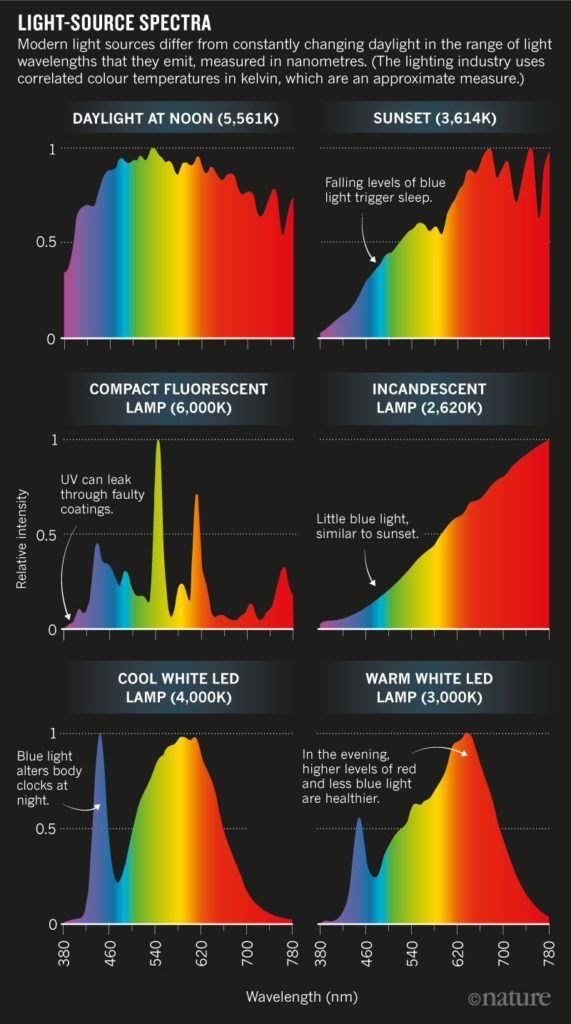Circadian Rhythm, Sleep
A Look Back at the Year and the Decade

Article at a Glance:
- Certain types of light can have a very lengthy list of potential health outcomes.
- In 2014, the American Academy of Pediatrics (AAP) publicly acknowledged that sleep deprivation is one of the most common, important, and potentially remediable health risks in all children and adolescents.
- Hunter-gatherers aligned their sleep/wake cycle with the natural rise and fall of the sun.
- Not all blue light is bad!
- Junk light can have both short and long-term health consequences that affect how you sleep, feel, and show up in the world every day.
A Look Back at the Year and the Decade
This was a BIG year and decade for light and health – specifically how light affects sleep, recovery, performance, and more. It has become abundantly clear that certain types of light can have a very lengthy list of potential health outcomes, including but not limited to muscle recovery, pain relief, improved circulation, anti-aging benefits, better sleep, and more energy. On the other hand, unhealthy “junk” light can have serious adverse effects on the mind and body and impede how you show up in the world every single day. Continue reading for a compiled list of some of the greatest light and health learnings over the past decade, as well as new wellness products, and key events that happened!
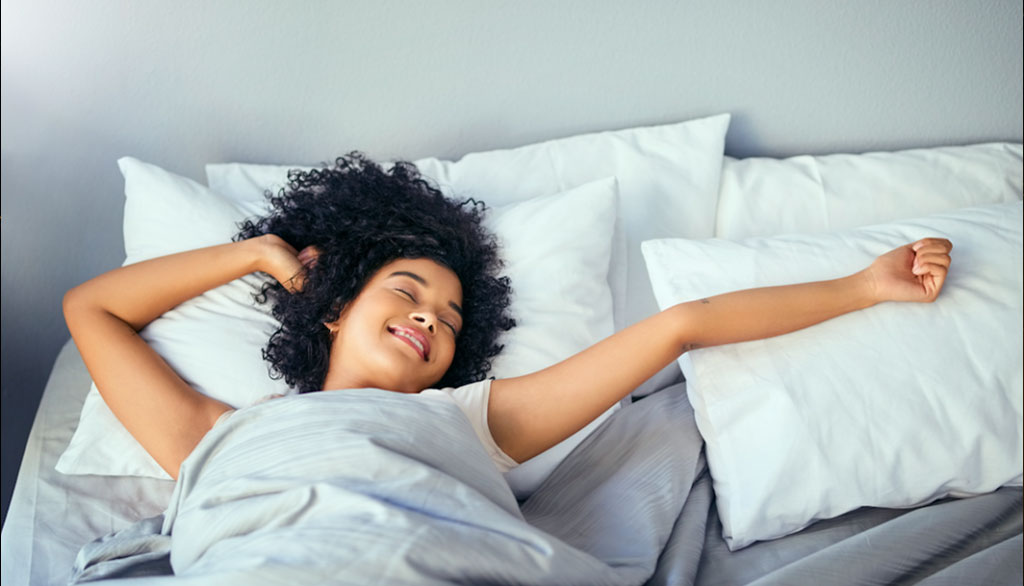
People Have Quite Literally Woken Up to the Importance of Sleep
Think back to when you were in grade school. Do you remember your teachers telling you how important it was to exercise and maintain a healthy diet? Most did, as this has historically been common practice. Now, consider sleep; did your teachers encourage healthy sleep habits as much as they advocated for fitness and nutrition? Chances are that they didn’t, but the good news is that sleep education is changing for the better.
In 2014, the American Academy of Pediatrics (AAP) publicly acknowledged that sleep deprivation is one of the most common, important, and potentially remediable health risks in all children and adolescents. According to research, 70% of college students suffer from poor sleep which has been associated with a reduction in academic performance, difficulty focusing, impaired driving, risk-taking behavior, depression, impaired social relationships, and poorer health. Thanks to growth in sleep science, sleep has officially been deemed as important to health and well-being as food and fitness. Now, more and more schools around the world are incorporating sleep hygiene into school curriculums. Some states are going so far as to enforce new laws that adjust school start and ends times and support students’ growth and development. The outcome: heightened awareness about sleep hygiene, and a greater likelihood of helping children and adolescents establish a foundation for healthy sleep practices. Universities are also taking proactive steps to improve sleep behaviors in college students with the help of sleep programs.
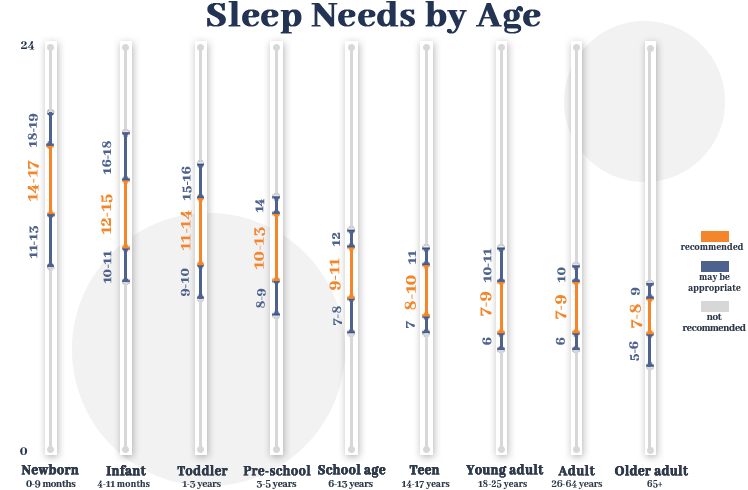
Source: Sleep Foundation, Graphic by Sleep Advisor
Alongside the wave of sleep science, we saw a huge uptick in the number of books published on the topic of circadian health, sleep, and health. Some of our favorites were Why We Sleep, The Circadian Code, Sleep Smarter, and The Sleep Revolution! While they each offered a unique perspective – based on their own experiences and research – there was a clear common thread amongst sleep scientists, life coaches, and media powerhouses: it’s time to embrace the sleep revolution and renew your relationship with rest.
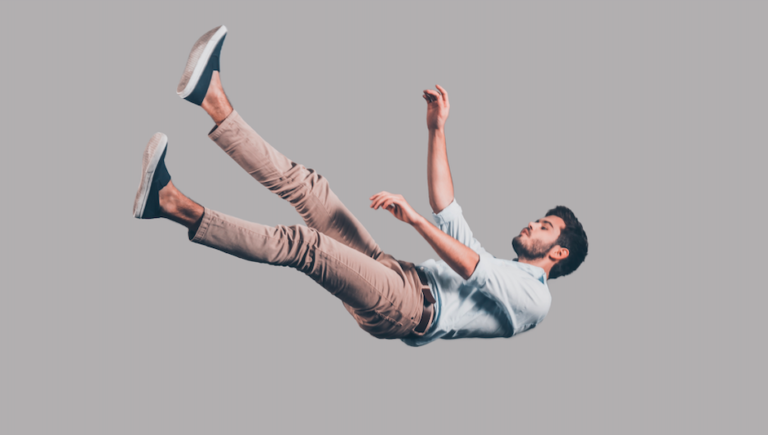
Sleep or Die
It may sound dramatic, but it’s the truth. Humans are reportedly the only mammals to consciously delay or opt not to sleep, which can have both short term and long-term consequences:
- It directly affects cognitive performance, making it harder to think, focus, remember, and multi-task.
- Your decision-making skills, innovative thinking, and reaction times also get a bit dumbed down.
- One night of bad sleep is enough to raise levels of amyloid beta – a substance which can clump together and create plaque in your brain that’s toxic to nerve cells.
- One night of bad sleep can reduce natural killer cell activity (which protects your body from cancer cells) by as much as 70%.
- Lack of sleep increases damage to DNA and rate of cell death; cellular health directly affects aging and the body’s functionality.
- According to Matthew Walker, a neuroscientist and sleep researcher at UC Berkley, one night of sleep deprivation can also cause a level of anxiety that would fall under the umbrella of a clinical anxiety order diagnosis.
- One week of sleeping fewer than six hours a night may result in changes to more than 700 genes.
- An estimated 7% of all motor vehicle crashes in the U.S. and 16% of fatal crashes involve drowsy driving (ScienceDaily). Note: “”Being awake isn’t the same as being alert. Falling asleep isn’t the only risk. Even if they manage to stay awake, sleep-deprived drivers are still at increased risk of making mistakes — like failing to notice something important or misjudging a gap in traffic — which can have tragic consequences,” says Brian Tefft, Senior Researcher for the AAA Foundation.
- Shift workers (people who work outside of the typical 9-to-5 window) are at greater risk for experiencing circadian rhythm disorders and sleep deprivation, which the World Health Organization (WHO) has classified as a “potential carcinogen”.
- Lack of sleep has been linked to weight gain, mood disorders, diabetes, and several different types of cancer (including breast, prostate, and brain cancer, as well as leukemia and non-Hodgkin’s lymphoma).
The bottom line: not getting enough quality sleep makes it harder for the body to fight off illnesses ranging from the common cold to cancer. The notion that one sleepless night is nothing to worry about is a common but false misconception that needs to be taken seriously because sleep hygiene is an important factor of quality of life.
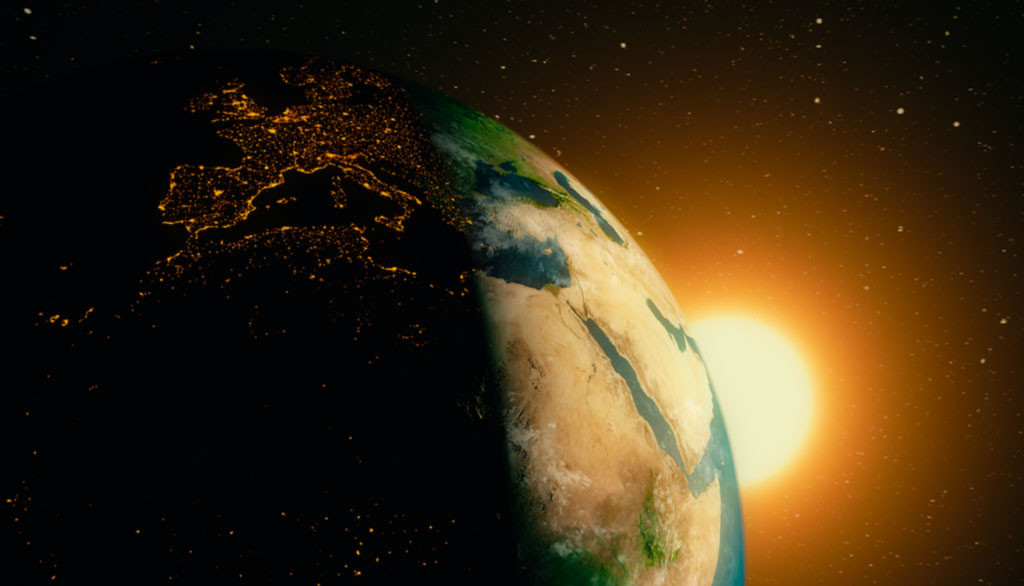
Light Directly Influences Your Sleep/Wake Cycle
Going back to the very basics of natural sleep patterns — before the light bulb revolution, the use of alarm clocks and medications, the development of smartphones, challenging work schedules, and other factors – hunter-gatherers aligned their sleep/wake cycle with the natural rise and fall of the sun. More specifically, they would wake up as the sun ascended into the sky; and when it got dark, they would prepare to go to sleep. Why? Because light is a biological driving force behind this 24-hour cycle. When the sun illuminated the sky, it was also easier to hunt.
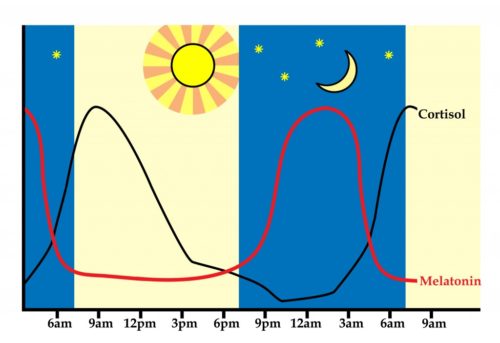
Cortisol, melatonin, and light are key mechanisms of the sleep/wake cycle. Cortisol is a steroid hormone that’s responsible for maintaining cellular health and the communication that happens between every cell in your body,” According to Aviva Romm, M.D., integrative medicine doctor and herbalist, “When it is in a healthy rhythm, cortisol is highest in the morning to give us the energy to get our day started, keep inflammation low, and keep immune response at its peak. It is naturally lowest before bed, allowing us to wind down into a rest-and-repair phase.”
Melatonin is a hormone made by the pineal gland, and it serves as the secret ingredient for helping you fall and say asleep at night. When the sun goes down and darkness occurs, the suprachiasmatic nucleus (SCN), which lies at the center of the body’s master clock, activates the pineal gland and begins to actively produce melatonin, which is released into the blood (Sleep Foundation). 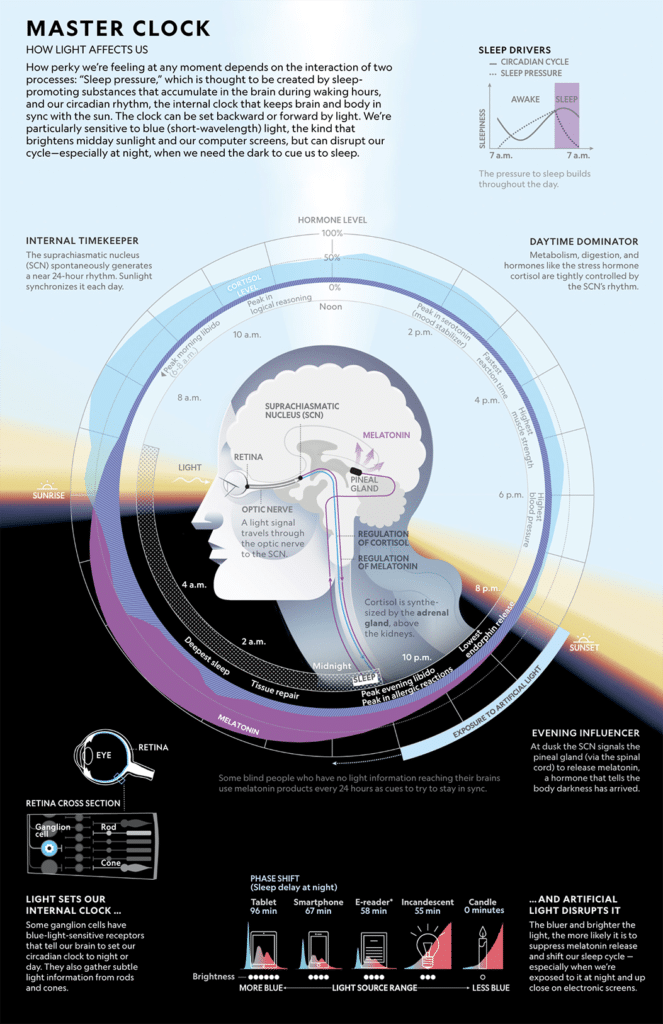
Source: National Geographic, Science of Sleep
When it comes to light, blue wavelengths appear to have the most impact on the body’s master clock. Satchin Panda, a leading expert in the field of circadian rhythm research and Professor at the Salk Institute, is credited for discovering melanopsin cells in the retina of the eyes that sense blue light – which entrains the body’s master circadian clock, affects mood, and regulates the production of melatonin.
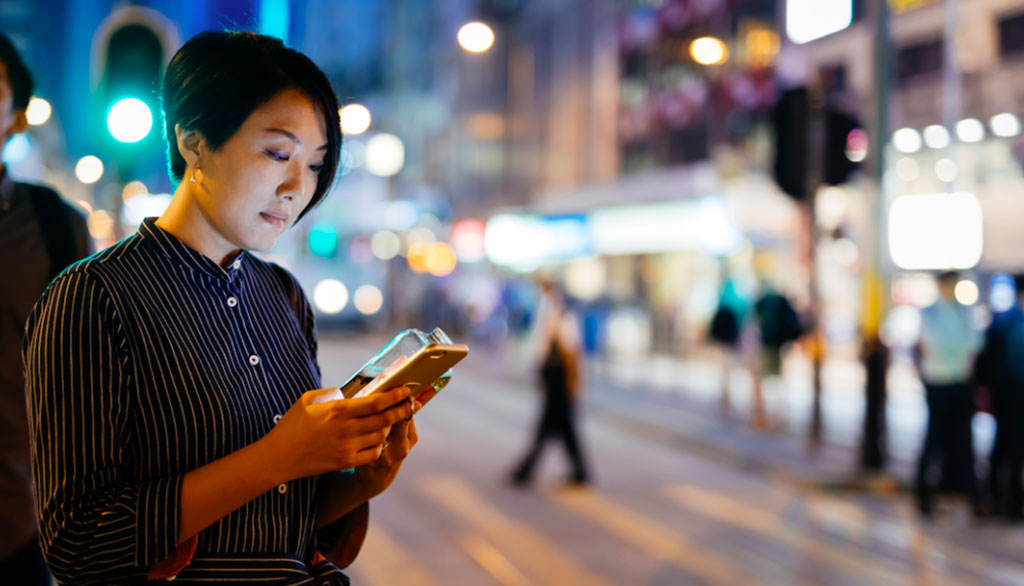
Not All Blue Light is Bad, But Overexposure to Artificial Blue Light Can Be
Over the past couple of decades, blue light has gotten a very negative reputation thanks to blanket statements, especially around eye health and insomnia. The truth is: not all blue light is bad! The sun produces natural blue light, which is part of the visible light spectrum. Moderate sunlight exposure can:
- Boost “happy hormones” like serotonin, which helps improve mood and focus, while also keeping you calm and alert.
- Decrease the risk of depression in those at risk of seasonal affective disorder (SAD).
- Help you produce more natural melatonin at night and improve your sleep.
- Strengthen your immune system.
Source: Nature
Unlike our hunter-gatherer ancestors, society has shifted from relying solely on the sun upon illuminance to an “always-on”, on-the-go lifestyle thanks to the development of artificial light – or as we like to call it, “junk light”. The unanticipated revolution of artificial (fluorescent and LED) light sources goes beyond providing light for vision; it also delivers a much higher amount of blue light compared to other light sources (incandescent, halogen, fluorescent) (Nature). Blue light notably has very short wavelengths that produce a lot more energy compared to longer wavelengths. Overexposure to the artificial stuff is what brings out blue light’s dark side. In fact, blue junk light can:
- Cause eye strain and fatigue, especially if you’re sitting in front of screens or under artificial lighting for extended periods of time.
- Decrease natural melatonin production and secretion, thereby delaying sleep and disrupting your circadian rhythm.
- Damage photoreceptor cells in the eyes and accelerate blindness, according to a recent study by the University of Toledo.
- Increase your risk of developing breast or prostate cancer.
In addition to blue light, studies have also shown that green and violet light at night may disrupt your sleep too. (That’s why TrueDark® Twilights are designed to block out blue, green, AND violet light.) Remember, if junk light is disrupting your sleep, then you’re at greater risk of experiencing a whole slew of serious health issues.
The bottom line: “Junk light is worse than junk food,” according to Dave Asprey. He says:
Exposing yourself to junk light instead of sunlight or incandescent light, which contains less blue light than other artificial sources, is kind of like the difference between eating a normal meal and eating a bowl of sugar containing the same number of calories. Blue light is the high-fructose corn syrup of lighting. And when you consider the fact that the average American spends 93% of his or her life under artificial lights, most often fluorescent or LED, it’s no surprise that the incidence of all Four Killers [Alzheimer’s, cancer, diabetes, and cardiovascular disease] is on the rise. (Source: Thrive Global)
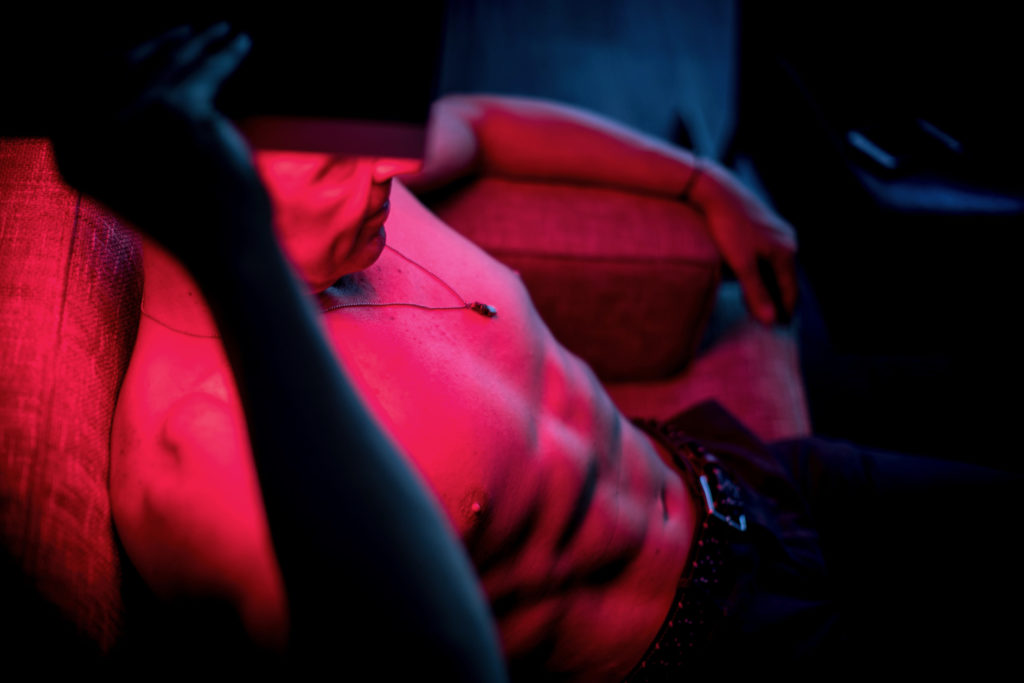
When it Comes to Photobiomodulation, Wavelengths, Power Density, and Dosage Make all the Difference
The term “photobiomodulation” (PBM) was universally accepted in 2015. The use of this term is key, as it distinguishes itself from more than 70 different terminologies, including low-level light/laser therapy, cold laser, and photostimulation. PBM therapy is notably nonthermal whereas the purpose of many light-based devices is to heat tissues in the body using near-infrared (NIR) lamps or other applications of light energy that rely on thermal effects for all or part of their mechanism of action (NCBI).
So, which wavelengths are the most beneficial for healing, and what do they do? Red light wavelengths range from approximately 620 nm to 750 nm. Studies show that 630 nm (red) and 660 nm (deep red) are the most effective wavelengths within this range; this is where your mitochondria can absorb red light easily which roughly coincide with the absorption peaks of cytochrome c oxidase (the target of light therapy). Potential health benefits include:
- Increased ATP production and cellular growth
- Faster muscle recovery
- Enhanced blood circulation
- Increased collagen production and radiant skin
- Reduces scars, wrinkles, & fine lines
- Accelerated wound healing
- Pain relief
- Anti-inflammatory effects
Near-infrared (NIR) light therapy is similar to red light therapy but it is invisible to the human eye, and it penetrates the body deeper — reaching down into soft tissues, muscles, joints, and bone. This range extends from 750 nm to 1,200 nm, with 810 nm, 830 nm, and 850 nm being the most effective. These wavelengths travel through skin and muscle tissue and activate color-sensitive chemicals to promote faster healing.
While red and NIR light are the most common lights found in photobiomodulation devices, yellow (or amber) light (570nm to 620nm) may also be helpful for healing the body – especially the surface of the skin given its very shallow penetration level. Yellow light stimulates the production of red blood cells, which play a vital role in skin healing and skin cell rejuvenation. It is often recommended as a drug-free alternative treatment for treating skin issues that involve redness, irritation, rosacea, UV radiation damage, swelling, and burns. Note: combining yellow, red and NIR can help rejuvenate the skin and heal the body faster.
With all of that said, photobiomodulation is relatively easy to do, but difficult to get right. By that we mean: there is in fact an optimal threshold for light dosage: 10-20 mW/cm2. Human tissue exhibits a biphasic dose-response to light, meaning that the benefits can disappear by using too much light and become toxic.
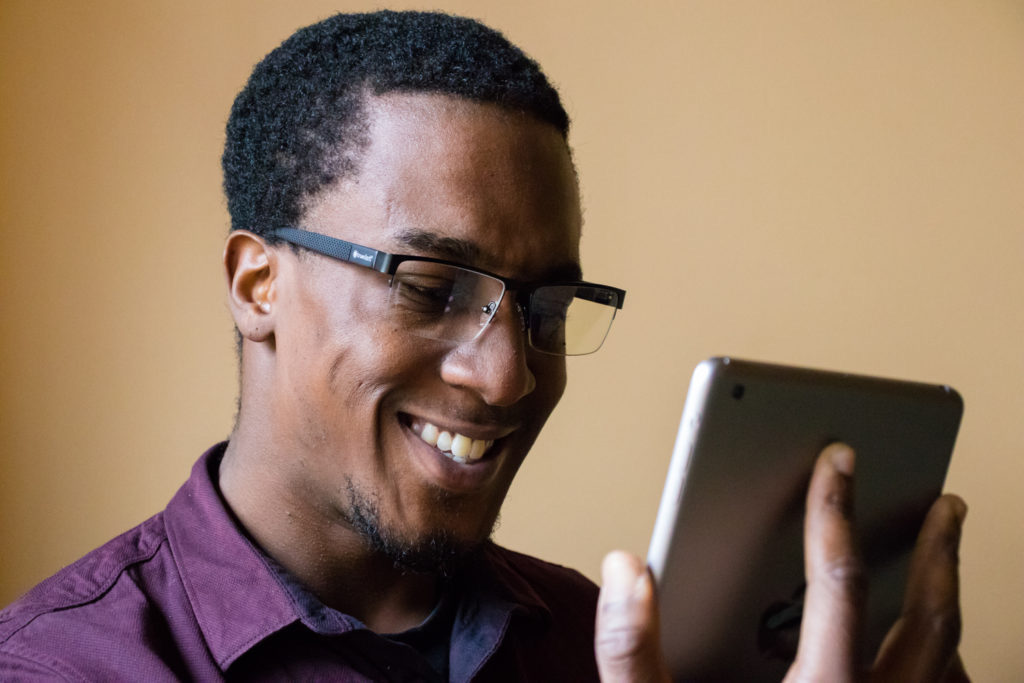
ICYMI: Here’s A Quick Recap of This Year’s Product Launches
2019 was a very exciting year for us because we introduced several new products that help people #stopjunklight and leverage healthy light/energy!
First, we launched FOUR new daytime lenses with clear lenses:
- Daylights™ Grey Tortoiseshell Pro
- Daylights™ Reading Glasses (+1 to +2.5)
- Daylights™ Transition Sunglasses
- Daylights™ Aviator Transition Sunglasses
Clear lenses can block a maximum of 40% of blue light. They are ideal for people who spend extended amounts of time in front of screens or under artificial lighting, especially if they experience chronic eye strain and/or fatigue. Note: clear lenses do NOT block as much junk light as TrueDark® Daylights™ with yellow lenses (75%), but they are perfect for people who need to see true colors on screens, stay in uniform at work, or simply don’t feel comfortable wearing yellow lenses. Blocking 40% of blue light is way better than blocking 0%!
Another key feature that we introduced to the blue light blocking market is transition lenses (used specifically in our sunglasses). Blue blockers are really intended for indoor use while exposed to artificial light sources, but TrueDark® sunglasses have a dual purpose; when you wear them outside, the lenses darken, and they also block UVA/UVB rays. 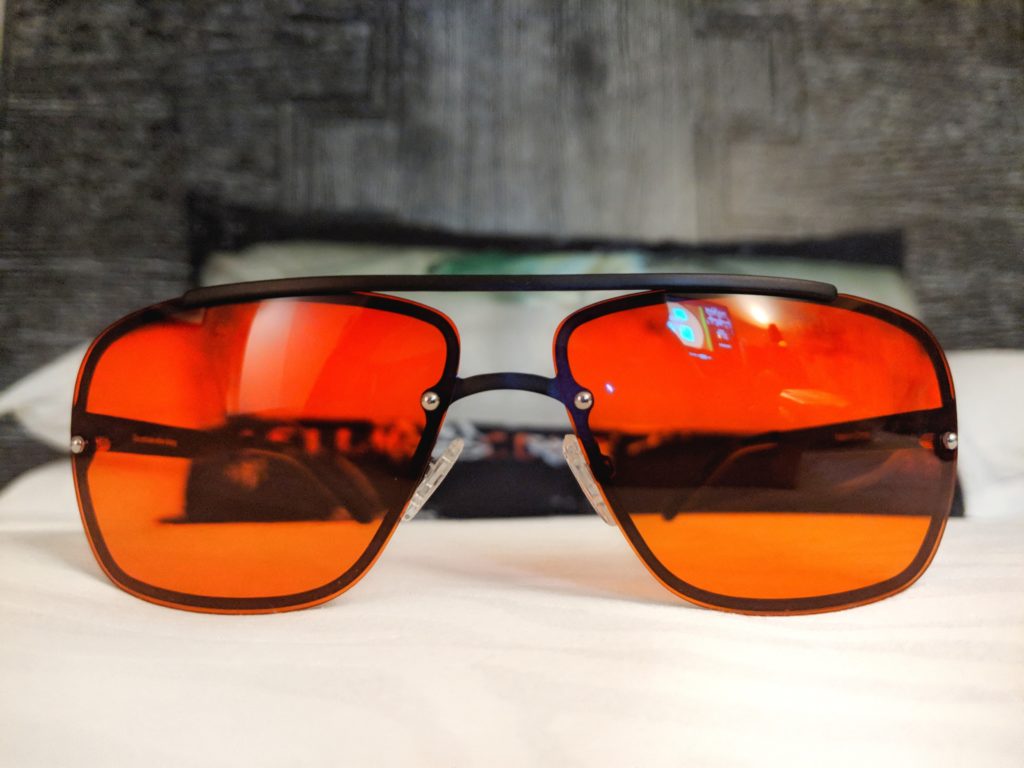
For nighttime, we introduced something completely new and different than any other blue blockers on the market: the TrueDark® Twilights Sunset style. While our Twilights (nighttime) styles are known for blocking out as much junk light as possible at night (up to 100%!), we wanted to create a true in-between solution that would allow people to preserve their health and live in harmony with technology, even if their lifestyle wouldn’t allow them to turn off all of the lights (workaholics, we are looking at you!). The TrueDark® Twilights Sunset lenses use a patent-pending gradient that is darker on top and lighter on the bottom so that the user can see, read, and write into the later hours of the evening without delaying or compromising the quality of their sleep. Like our other Twilights styles, the Sunsets are a helpful tool for preventing jet lag. (They are also Dave Asprey’s personal new favorite!)

We’re happy to share that in 2019 we also launched all-new TrueDark® Kids glasses for boys and girls ages 3-7! They use the same technology as our adult glasses; Kids Daylights™ have yellow lenses that block 75% of blue light, and Kids Twilights have red lenses that block 98% of blue, green, and violet wavelengths.
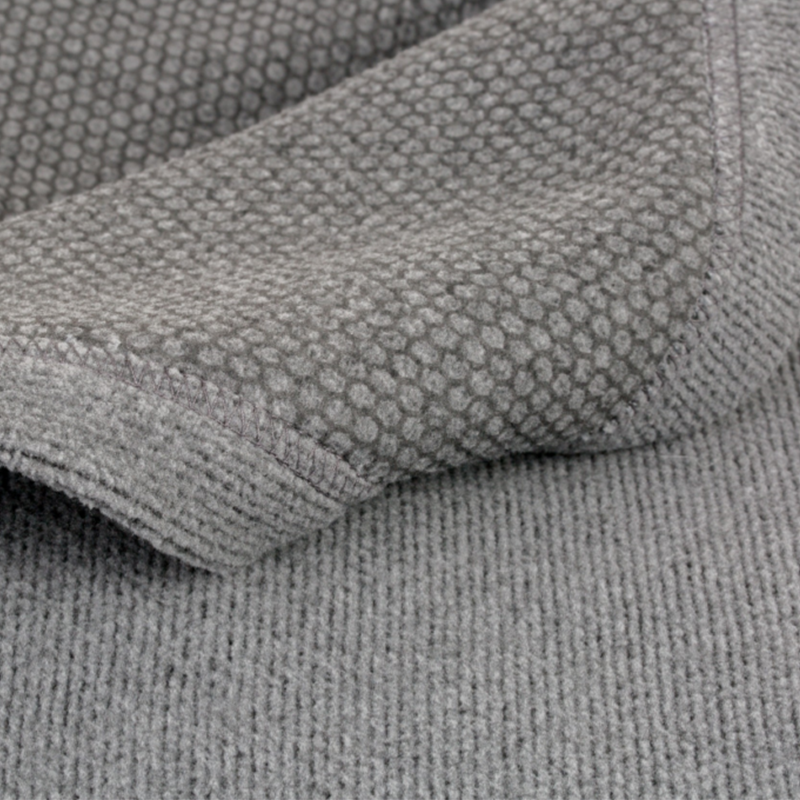
More recently, we also introduced the TrueLight® Regenerative Blanket – a bioceramic textile that you can use to harness your body’s natural energy and improve your quality of life. It specifically has bamboo charcoal infused in the fabric, which can have many potential benefits, including but not limited to:
- Increased blood circulation
- Improved oxygen flow
- Tissue regeneration
- Pain relief
- Reduced inflammation
- Muscle Recovery
- Better sleep
- Better performance
This blanket is the perfect companion for any TrueLight® photobiomodulation device! 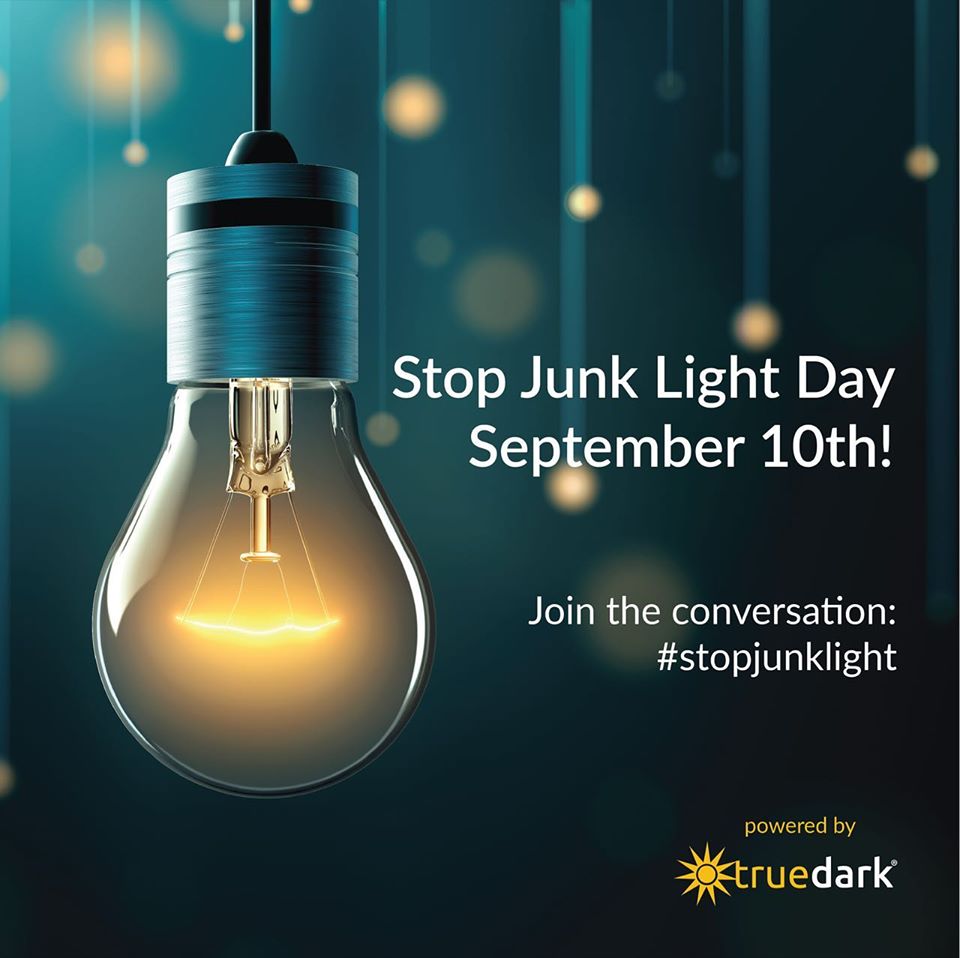
Stop Junk Light® Day
On September 10th, we celebrated the 2nd annual Stop Junk Light® Day, which aims to raise awareness about the dangers associated with overexposure to junk light, and how to combat them. Please don’t forget to mark this date on your 2020 calendar, we promise that we’re going to celebrate BIG!

Some Final Thoughts as we Leave the Year and Decade Behind
There is resounding evidence that the human body needs various amounts of specific light wavelengths at different times of day (and night) in order to carry out important biological functions. Conversely, junk light can have both short and long-term health consequences that affect how you sleep, feel, and show up in the world every day. With that said, much more research needs to be done in order to:
- Reveal the connection between overexposure to (blue, green and violet) junk light, diseases and cancers
- Confirm the dangers of shift work and potentially promote changes in employment practices across different industries
- Continue to raise awareness about the junk light problem – for both humans and animals – and help promote behavioral changes at home and in public settings
- Confirm or invalidate health claims related to specific wavelengths of light and assisting with a variety of health issues, including but not limited to:
- Accelerating wound/injury healing
- Improving hormonal health
- Improving cognitive function
- Improving energy levels and mood
- Improving blood circulation
- Fat loss
- Chronic inflammation
- Oxidative damage and anti-aging
- Increasing strength, endurance, and muscle mass
- Decreasing pain
- Combating hair loss
- Building resilience to stress at the cellular level
Going into 2020, we will continue keeping a close eye on published research related to junk light and photobiomodulation. If you’d like to be kept in the know, please be sure to sign up for our newsletter. In addition to getting relevant news articles and studies sent right to your inbox, you’ll also be the first to know about sales happening on our website. You won’t want to miss these; we have a LOT planned for 2020. 😉


